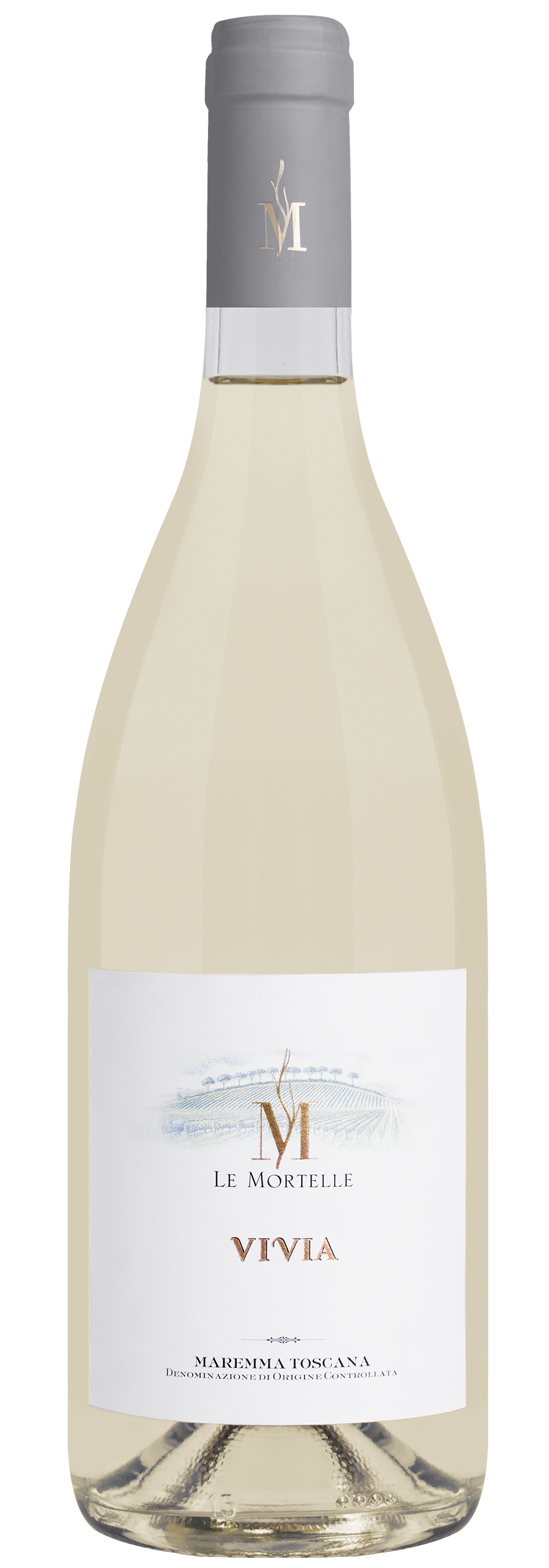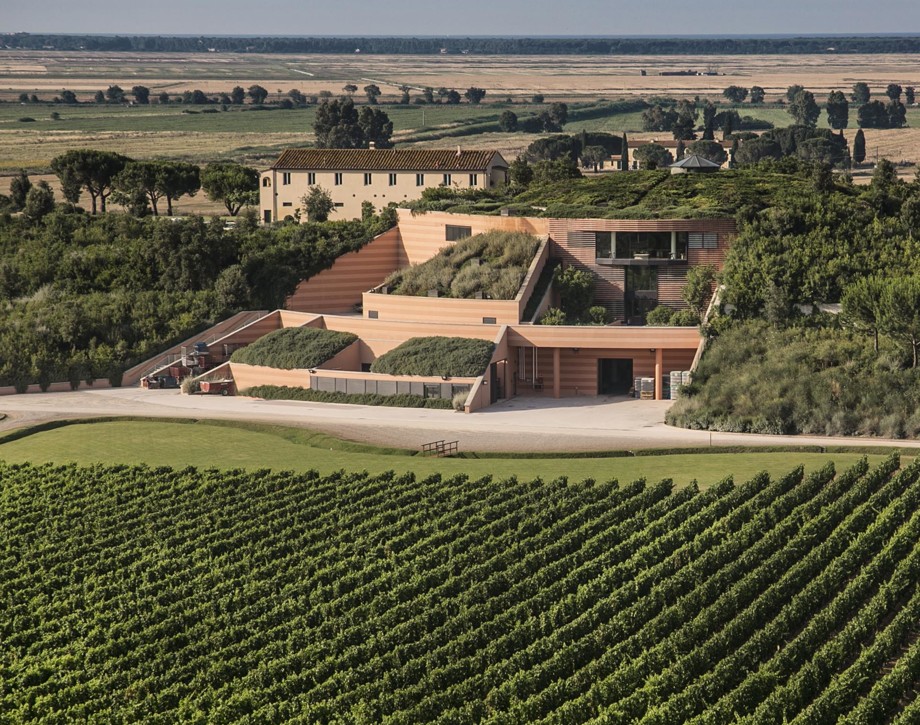Vivia

Climate
The 2017 vintage, characterized by a generally mild winter and a warm and dry springtime, saw an early start to the growing season of the vine, which then came back into line with a regularly-timed bud set. The optimal management of the irrigation aided in a usefully sustaining the vines during a summer season marked by an absence of rainfall and temperatures above normal seasonal averages, guaranteeing a perfect growth and development of the grape bunches. The Viognier harvest was an early one, with the grapes characterized by the classic notes of ripe fruit, and continued in early September with the Vermentino, fragrant and with a good freshness. The Ansonica, instead, was picked late, in early October, in order to give the wine the proper structural and aromatic components.
Vinification
The grapes, as soon as they arrived in the cellar, were given a soft pressing and fermented variety by variety in order to best bring out the characteristics of each single variety. The must was then chilled to a controlled temperature of 50° Fahrenheit (10° centigrade) to assist a natural static settling of impurities. The clean must went into stainless steel fermenting tanks, where it fermented at a temperature held to 61° Fahrenheit (16° centigrade). The wine then remained in stainless steel on its fine lees for approximately three months before being bottled in January of 2018.
Historical Data
The Mortelle estate is in the heart of Maremma in Tuscany, near the town of Castiglione della Pescaia set in an extraordinary and fascinating position both for the territory’s unparalleled natural beauty and its historical heritage and culture. The Antinori family has been part of this territory for generations. Evidence of ownership of land in this area is recorded on a property deed dated 1863. It states their ownership of Poggio Franco, one of the best vineyards on the estate, together with other parcels of land. Since 1999, when the property was acquired, the family has dedicated their efforts to improving the vineyards and building the new winery with the firm belief that this area, slowly emerging on the Italian viticultural horizon, has great potential for the production of high quality wines. Varieties grown in this area can fully express their own characteristics as well as the exceptional qualities of the terroir. The soil is of medium consistency, sandy and loamy composed of clay and silica and in some parts of the estate is rich in rocky deposits. Vermentino and Ansonica, typical grape varieties cultivated in Tuscany’s costal area, grow alongside Viognier, a vine that has recently been planted after years of patient research to produce an elegant white wine expressing the colors and aromas of the Maremma coastline.
Tasting Notes
The 2017 Vivia shows a straw yellow color with brilliant greenish highlights. The nose is dominated by a sweet and pleasurable intensity, a characteristics of the vintage. Notes of ripe white fruit fuse with exotic aromas of pineapple and mango and are followed by delicate hints of white flowers and lemons. The palate is savory and vibrant with a crisp, persistent finish and a citrus fruit aftertaste of citron zest.
Awards
Luca Maroni 92/100 ITA

The Wine
This wine is harvested from vineyards indigenous to the Tuscan coast, a blend of Vermentino and Viognier and a small percentage of Ansonica: a successful result of patient research that produced an elegant white wine expressing the colors and aromas of the Maremma coastline.

Climate
The 2017 vintage, characterized by a generally mild winter and a warm and dry springtime, saw an early start to the growing season of the vine, which then came back into line with a regularly-timed bud set. The optimal management of the irrigation aided in a usefully sustaining the vines during a summer season marked by an absence of rainfall and temperatures above normal seasonal averages, guaranteeing a perfect growth and development of the grape bunches. The Viognier harvest was an early one, with the grapes characterized by the classic notes of ripe fruit, and continued in early September with the Vermentino, fragrant and with a good freshness. The Ansonica, instead, was picked late, in early October, in order to give the wine the proper structural and aromatic components.
Vinification
The grapes, as soon as they arrived in the cellar, were given a soft pressing and fermented variety by variety in order to best bring out the characteristics of each single variety. The must was then chilled to a controlled temperature of 50° Fahrenheit (10° centigrade) to assist a natural static settling of impurities. The clean must went into stainless steel fermenting tanks, where it fermented at a temperature held to 61° Fahrenheit (16° centigrade). The wine then remained in stainless steel on its fine lees for approximately three months before being bottled in January of 2018.
Historical Data
The Mortelle estate is in the heart of Maremma in Tuscany, near the town of Castiglione della Pescaia set in an extraordinary and fascinating position both for the territory’s unparalleled natural beauty and its historical heritage and culture. The Antinori family has been part of this territory for generations. Evidence of ownership of land in this area is recorded on a property deed dated 1863. It states their ownership of Poggio Franco, one of the best vineyards on the estate, together with other parcels of land. Since 1999, when the property was acquired, the family has dedicated their efforts to improving the vineyards and building the new winery with the firm belief that this area, slowly emerging on the Italian viticultural horizon, has great potential for the production of high quality wines. Varieties grown in this area can fully express their own characteristics as well as the exceptional qualities of the terroir. The soil is of medium consistency, sandy and loamy composed of clay and silica and in some parts of the estate is rich in rocky deposits. Vermentino and Ansonica, typical grape varieties cultivated in Tuscany’s costal area, grow alongside Viognier, a vine that has recently been planted after years of patient research to produce an elegant white wine expressing the colors and aromas of the Maremma coastline.
Tasting Notes
The 2017 Vivia shows a straw yellow color with brilliant greenish highlights. The nose is dominated by a sweet and pleasurable intensity, a characteristics of the vintage. Notes of ripe white fruit fuse with exotic aromas of pineapple and mango and are followed by delicate hints of white flowers and lemons. The palate is savory and vibrant with a crisp, persistent finish and a citrus fruit aftertaste of citron zest.
Awards
Luca Maroni 92/100 ITA

Fattoria Le Mortelle
The Mortelle estate is in the heart of Maremma in Tuscany, near the town of Castiglione della Pescaia set in an extraordinary and fascinating position both for the territory’s unparalleled natural beauty and its historical heritage and culture. The Antinori family has been part of this territory for generations. Evidence of ownership of land in this area is recorded on a property deed dated 1863. It states their ownership of Poggio Franco, one of the best vineyards on the estate, together with other parcels of land. Since 1999, when the property was acquired, the family has dedicated their efforts to improving the vineyards and building the new winery with the firm belief that this area, slowly emerging on the Italian viticultural horizon, has great potential for the production of high quality wines. Varieties grown in this area can fully express their own characteristics as well as the exceptional qualities of the terroir. The property extends over an area of 270 hectares (667 acres) 170 of which (420 acres) are planted with vineyards of Cabernet Sauvignon, Cabernet Franc and other more recently planted vineyards with white grape varieties such as Vermentino, Ansonica, Viognier and a small parcel of Carménère. The soil is of medium consistency, sandy and loamy composed of clay and silica and in some parts of the estate is rich in rocky deposits.

Soil
Loamy soil with sand and silt.
















